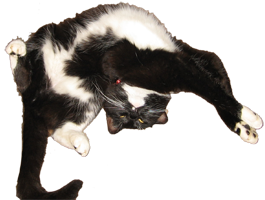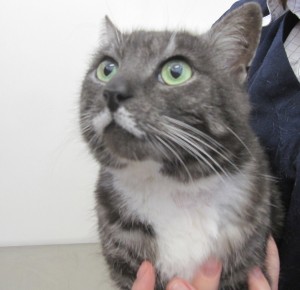 Mojo is very popular with us all at Hall Vet Surgery, and of course much loved by his family. Two weeks ago he disappeared for a night and when he came home couldn’t get interested in his food – very unusual for MoJo and most distressing for all his fans!
Mojo is very popular with us all at Hall Vet Surgery, and of course much loved by his family. Two weeks ago he disappeared for a night and when he came home couldn’t get interested in his food – very unusual for MoJo and most distressing for all his fans!
When we saw him we found a few scabs on his head, presumed he’d been in a brawl and sent him home with antibiotics.
Although we noticed a heart murmur we didn’t take much notice of it because many cats have murmurs and never show signs of them.
Next day his owner searched the house for him. She found him hiding in a cupboard and still not the slightest bit interested in breakfast. His breathing seemed a little laboured so we took an X ray of his chest. His heart was hidden by fluid around the lungs.
We drained the fluid and he was much happier. It was clear fluid, possibly as a result of his heart murmur. An ultrasound confirmed that he has hypertrophic cardiomyopathy and that his heart is failing to pump efficiently.
Just as we thought we could let him go home on fluid removal medication he started limping on a front leg.
Cats with heart failure sometimes throw clots into the bloodstream which end up blocking vital arteries. Poor Mojo had a clot in the artery to his front leg. Fortunately it must have been a small one because with heparin therapy it dissolved and Mojo is on aspirin to prevent more clots forming.
Signs of heart failure are rare in cats even when they have murmurs we can easily hear with a stethoscope. When the blood is so turbulent that it causes clots the outlook can be very poor because clots are so hard to prevent.
Mojo is stable for the moment, enjoying his meals and spending a lot of time on his owner’s lap. Regular checks of his chest and blood pressure should help keep him feeling good and his fans happy for a long while yet.
Category Archives: Internal Diseases of Cats
Herpesvirus for cats…
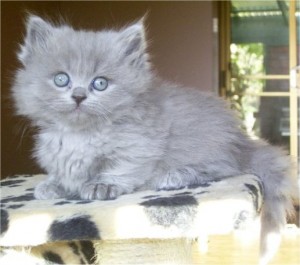 Yes – cats have their own herpesvirus, just as irritating as the human variety, and liable to flare up with stress just like it does in human sufferers. However cat herpesvirus mostly affects the eyes and respiratory system.
Yes – cats have their own herpesvirus, just as irritating as the human variety, and liable to flare up with stress just like it does in human sufferers. However cat herpesvirus mostly affects the eyes and respiratory system.
The great majority of cats suffer their first bout with herpesvirus when they are kittens. They get watery eyes, sneeze, snuffle, go off their food for a day or two and look very sad and fluey. Antibiotics to prevent secondary infections and good nursing pull nearly all of them through.
Although most infected cats then become carriers very few have any further trouble with the virus themselves.
A few poor cats go on to develop flu-like signs or various eye diseases whenever they are stressed.
Some just get watery eyes. Painful ulcers on the cornea, the window of the eye, and on the conjunctiva, make other cats very miserable. Occasionally a part of the cornea dies and turns black, or the eye perforates.
Any eye problem is an emergency. If your cat has watery or pussy eyes, is squeezing his eyelids closed, or the eye looks blue, red or black bring him straight in to the surgery.
Permethrin flea products toxic to cats
Flea products containing permethrin are highly toxic to cats.
 Products for dogs such as Advantix spot on for fleas and ticks and Permoxin, a spray, contain permethrin. Do NOT ever apply them to cats.
Products for dogs such as Advantix spot on for fleas and ticks and Permoxin, a spray, contain permethrin. Do NOT ever apply them to cats.
Cats which groom or sleep with dogs treated with these products in the previous 48 hours can be poisoned also.
Signs of toxicity include: tremors, twitching, drooling, incoordination, convulsions, coma and death. Some cats flick their paws, twitch their ears, or are sensitive to touch or sound. Vomiting and diarrhoea are also common.
Signs start within 1 to 3 hours of ingestion or application but can be delayed up to 12 hours. Effects can last more than 3 days.
More than 500 cases of permethrin poisoning have been reported in Australia. A quarter of these cats died despite treatment.
Tooth decay
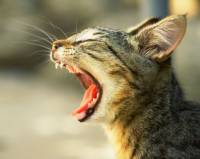
Plaque and bacteria mineralise on cat’s teeth to form tartar or calculus.
Tartar and red inflamed gums, or gingivitis, loosen teeth.
Holes in teeth at the gumline affect 80% of cats. These so-called neck lesions are intensely painful. Tartar builds on them and rubs the inside of the cheek. The only solution is extraction.
Cats with bad mouths show less interest in food or approach the food bowl eagerly then don’t eat. They chew cautiously, drop food from the mouth, or swallow with difficulty. Dribbling, blood-tinged saliva, and bad breath are common. In some cases affected cats paw the mouth or shake the head. Reluctance to eat may lead to weight loss.
Many cats show no signs of bad teeth despite being in pain. However after we clean their teeth they are obviously much happier and relaxed.
A scale and polish under general anæsthesia removes tartar and saves teeth.
Chunks of meat such as gravy beef or chicken thighs encourage chewing and prevent the build-up of plaque and tartar. Greenies are a palatable treat that clean the teeth as well. A bowlful of special dental foods such as Royal Canin dental or Hills t/d several times a week also prevent dental disease. Chewing meat and dental biscuits stimulates the production of saliva, which contains natural antibacterial substances, and scrapes plaque and tartar from the teeth.
Calicivirus vaccination of kittens helps prevent gingivitis.
Bladder worries
Indoor cats straining to urinate and not producing much but bloody urine have bladder problems. Some exhibit their frustration and pain all over the house.
The urinary passage of male or desexed male cats can block up with crystals and mucous. If your cat is tense and restless then he may have a blockage and you must contact a vet immediately before the bladder bursts.
Stress causes bladder inflammation or cystitis in some cats.
Kidney or bladder infections and bladder stones cause similar signs.
When you come to the vet surgery we examine your cat for urinary blockage and shock. Then we analyse your cat’s urine for infection, crystals and mucous plugs. We might order an X ray or ultrasound to rule out bladder stones.
If we find no sign of blockage, infection or stones then we conclude that your cat has Feline Lower Urinary Tract Disease (FLUTD) or Interstitial Cystitis (FIC).
Contributing causes:
No single cause of FIC has been identified. However, several factors have been shown to increase the risk of FIC. These include:
Stress
- Indoor confinement
- Dry food
- Obesity
- Low water consumption
- Sedentary lifestyle
- Frequent meals
How can you prevent further episodes of FIC?
- Introduce a predominantly wet food diet such as food in sachets or cans, or raw meat. If your cat prefers dry food you may have to introduce the new foods gradually. Add a little of the wet food to the biscuits and gradually increase the amount of wet food. Alternatively sprinkle the biscuits with water and increase the amount of water added over a few weeks until the biscuits are soft and wet.
- Increase your cat’s water intake. You might try adding more water to the food or offering water flavoured with chicken stock. Some cats like running water. Pet fountains are available in many pet stores. Cats often like drinking water from the shower recess or basin. Provide water in a variety of bowls in different shapes, sizes and textures to identify your cat’s preference. If rain water or filtered water is available your cat may prefer it to tap water.
- Encourage frequent urination. Provide at least one litter tray per cat plus one more filled with the preferred litter and in private locations.
- Reduce stress in your cat’s life. Some cats are very sensitive to their environment and may respond to any changes by becoming nervous or fearful and developing problems such as cystitis. A comfortable quiet hideout for resting, such as a cupboard, quiet bed or sofa, or on top of the refrigerator, is essential for all felines. Some nervous individuals may require a refuge in a quiet, sheltered part of the house away from other pets and people, and furnished with the necessities of life.
- Minimise interaction with other cats for fearful individuals. Check out the Indoor Cat website for signals that your cat is on edge. You may have to provide a feeding point, litter tray and hideout for each cat to minimise th
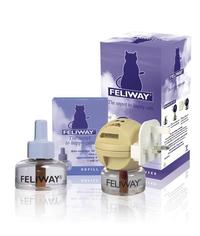 e tension.
e tension. - A Feliway diffuser may help to reduce stress in many situations.
- Enrich your cat’s environment. When we confine our cats indoors they become dependent on us not only for their physical needs and environment but for their emotional and intellectual needs as well. Cat scratching posts, toys that mimic prey, tunnels, outside runs and a variety of high spots and hideouts will keep your cat happy and stimulated. Your company is important. Even an old cat will appreciate a game with a ribbon on a stick or a glittery ball. Make your cat work for food by hiding it in various locations around the house or in food puzzles such as plastic containers with holes cut in the sides. The Indoor Pet website has lots of suggestions.

